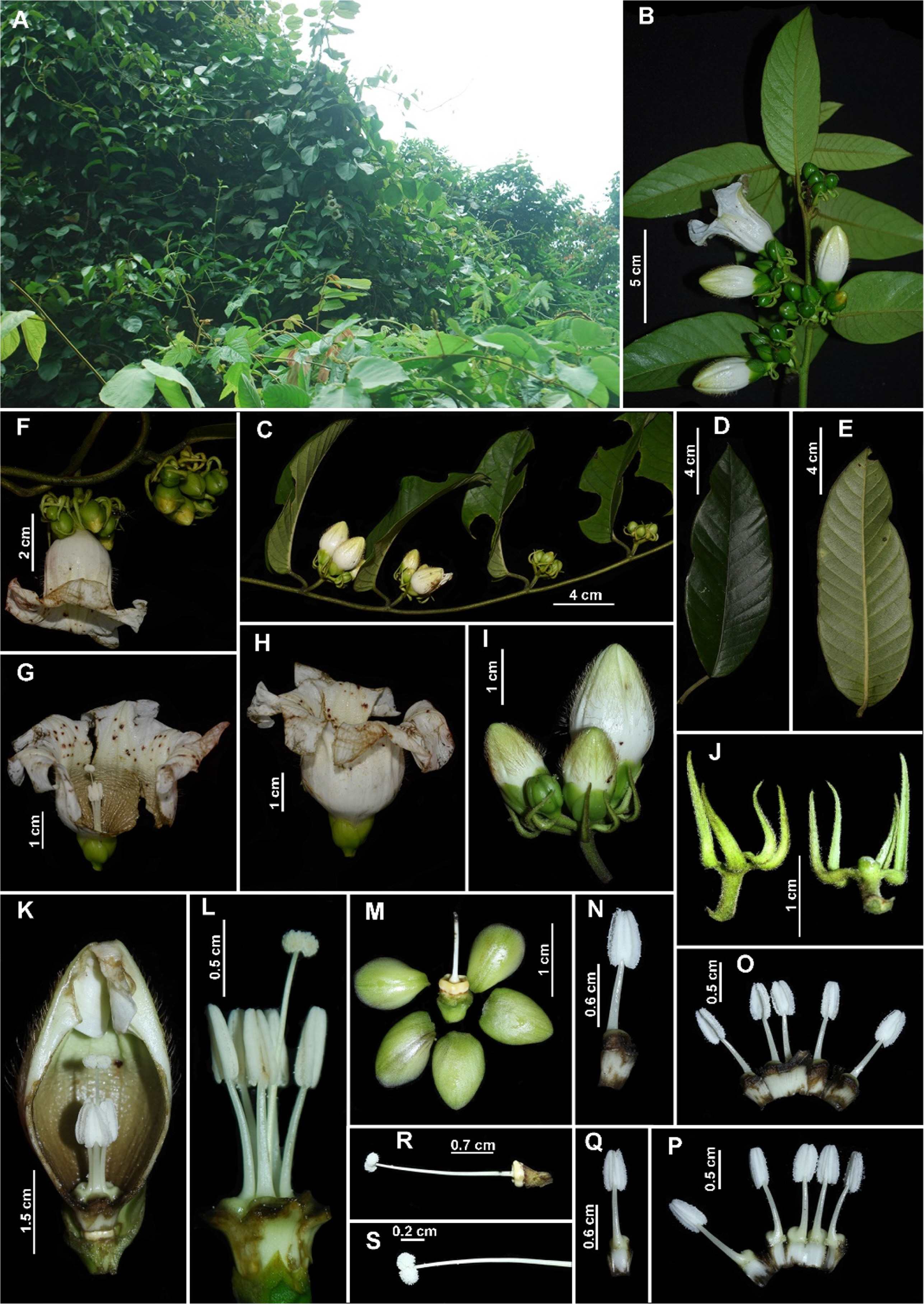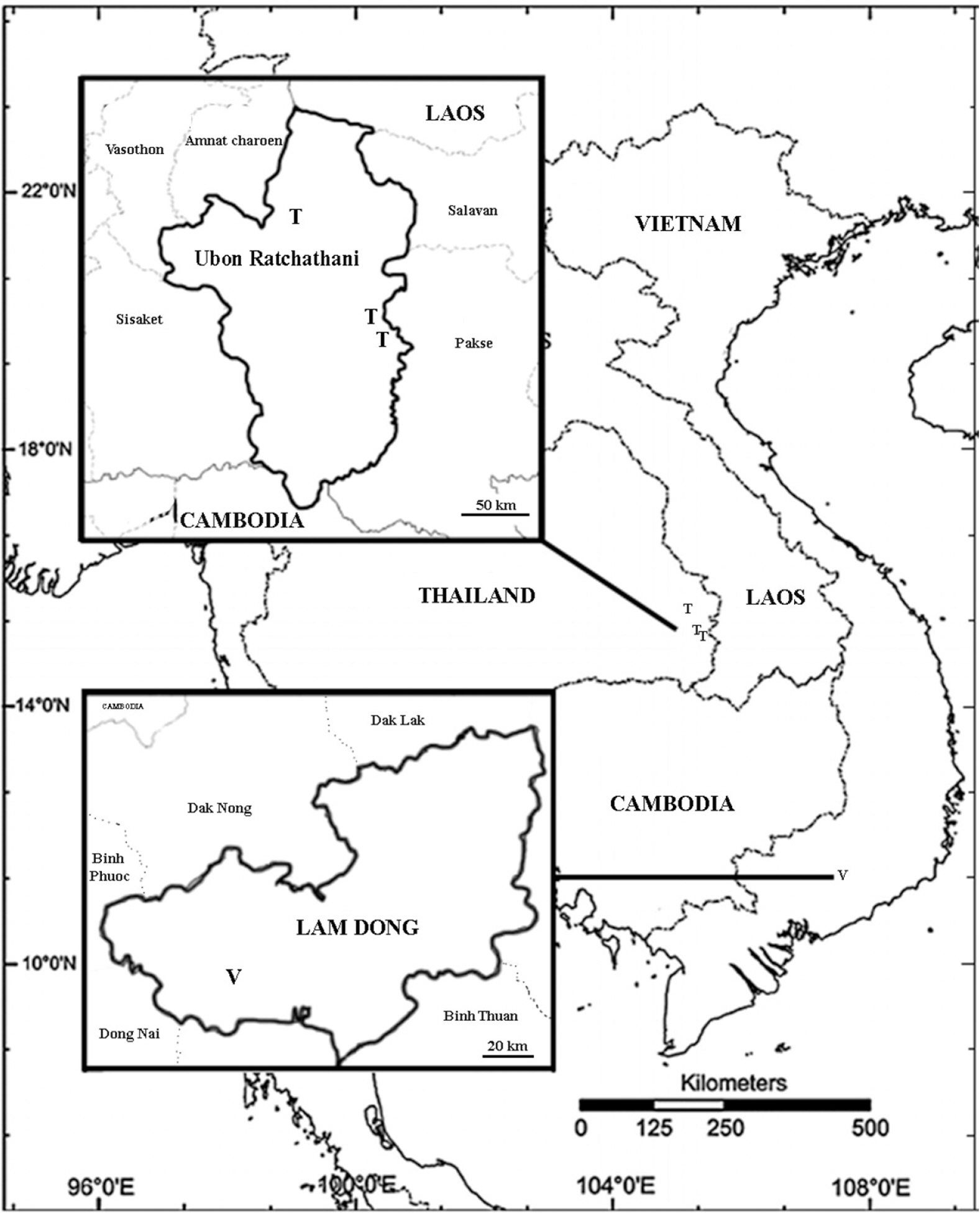Argyreia gyrobracteata Traiperm & Chitchak (Convolvulaceae): A new record to the flora of Vietnam
Article information
Abstract
Argyreia gyrobracteata Traiperm & Chitchak (Convolvulaceae) is newly recorded in Vietnam. It is similar to A. mekongensis Gagnep & Courch in having a white campanulate corolla but differs from that species by having whitish surface of the abaxial leaf, narrowly lanceolate or linear-oblong, curly, rolled up the bract with a longer length of the petiole and a shorter pedicel. It was previously known only in Thailand, but was recently found in Lam Dong Province, Vietnam, for the first time. The present study provides a detailed description, colorful photos and the distribution of the species. Furthermore, a comparison of the diagnostic characters between this species and a related species in Vietnam, A. mekongensis Gagnep & Courch, is provided.
The genus Argyreia Lour. (Gagnepain and Courchet, 1915), consists of 135 species distributed from Madagascar, Tropical & Subtropical Asia to N. Queensland (Mabberley, 2017; Chitchak et al., 2018). Thailand and Myanmar are species-rich countries having 37 species each (Traiperm and Staples, 2016; Traiperm et al., 2019), followed by 22 species in China (Fang and Staples, 1995), 18 species in Malaysia (Kiew et al., 2015), 16 species in Laos PDR (Staples et al., 2014) and 5 species in Cambodia (Cho et al., 2016). Argyreia is a genus of herbaceous climbers or scandent shrubs or lianas, flowers in cymes or capitula, corolla 5-lobed and fruit indehiscent or berry (Staples and Traiperm, 2010). It is similar to Ipomoea morphologically but differs in its fruit. The fruit of the former is indehiscent, fleshy, or mealy berries, whereas that of the latter is a dehiscent dry capsule (Kiew et al., 2015). Argyreia is a problematic genus in Convolvulaceae due to morphological complexity but no precise revisions or its monograph are available up to date, especially in Southeast Asia which is species rich for the genus (Traiperm and Staples, 2013, 2016; Shalini et al., 2017; Traiperm et al., 2019).
So far, sixteen species are recognized from Vietnam but again, comprehensive research including nomenclature review should be taken to confirm the actual number of species for the genus. An account of Argyreia in this paper relies on the foundation of Pham (1999) and Staples (2018) which has been accepted by taxonomists in Vietnam. During our regular survey work in Lam Dong Province, southern highland of Vietnam, we collected several specimens of Convolvulaceae. The genus is distributed throughout Vietnam and seven species have been reported from Lam Dong, A. mollis, A. osyrensis, A. lanceolata, A. laotica, A. longipes, A. mekongensis, and A. monosperma. Among these species, our specimen was morphologically similar to A. mekongensis (Table 1). On the basis of available literatures (Pham, 1999; Chitchak et al., 2018; Staples, 2018) and carefully checking herbarium specimens of Argyreia in Herbarium of the Institute of Ecology and Biological Resource (HN) Hanoi, finally it was identified as A. gyrobracteata Traiperm & Chitchak, a first record from Vietnam (Fig. 1). A. gyrobracteata differs from A. mekongensis by the whitish surface of its abaxial leaf, narrowly lanceolate or linear-oblong, curly, rolled up bract, longer length of the petiole and shorter pedicel. Previously A. gyrobracteata had been reported only in two different districts, Trakan Phut Phon and Sirindhorn in Thailand, the latter being located close to the border of Lao PDR (Chitchak et al., 2018) (Fig. 2). Interestingly, up to now, no record for A. gyrobracteata has been reported from Lao PDR and Cambodia, two countries located between Thailand and Vietnam (Newman et al., 2007; Cho et al., 2016). Therefore, a further study for A. gyrobracteata is needed to explain its discontinuous distribution in these regions. Here, we provide a detailed description, habitat, distribution, color photographs, and comparison table.

Argyreia gyrobracteata Traiperm & Chitchak. A. Habit. B, C, F, I. Flower with inflorescences. D. Adaxial leaf. E. Abaxial leaf. G, H. Flowers. J. Adaxial (left) and abaxial (right) bracts. K. Longitudinal section of flower buds. L. Filaments and style. M. Sepals. N–O. Front view of stamen. Q–P. Side view of stamen. R–S. Pistil. Photos by T.T.Bach and T.D.Binh.

Distribution map of Argyreia gyrobracteata Traiperm & Chitchak in Lam Dong Province, Vietnam (V) and two accessions at Trakan Phut Phon and Sirindhorn in Ubon Ratchathani province, Thailand (T).
Taxonomic Treatment
Argyreia gyrobracteata Traiperm & Chitchak. Botany. 96: 217–233, 2018 (Fig. 1)—TYPE: THAILAND. Ubon Ratchathani, Sirindhorn district, Chong Mek subdistrict, in the edge of dipterocarp forest, 15°07′20.8″N, 105°28′02.1″E, 20 Aug 2016, P. Rattanakrajang, N. Chitchak & P. Traiperm 110 (holotype BKF; isotypes K, QBG).
Description (based on the specimens from Vietnam cited below): Perennial creepers. Stems 5–7 m long; young branches yellowish pubescent. Leaves simple, entire; petiole 1.3–2.1 cm long, pubescent; leaf blade ovate or ovate-elliptic, 10.3–14.5 cm long, 4.6–6.5 cm wide; base obtuse, margin entire, apex acute to obtuse, adaxial surface green, glabrous, glabrescent or hairy on midrib and secondary veins; abaxial surface whitish, sericeous, secondary veins 9–15 pairs. Inflorescences axillary, pendulous, cymose, 4–6-flowered; peduncle 0.7–1.4 cm long, hairy; bracts 3 or 4, twisted, rolled up, subequal, narrowly lanceolate or linear-oblong, middle bract 1.5–2.5 cm long, 0.3–0.7 cm wide; side bracts 1.5–2.3 cm long, 0.2–0.7 cm wide, base cuneate, margin entire, apex long-attenuate, abaxial surface sericeous with whitish hairs, adaxial surface glabrescent; pedicels 0.4–0.6 mm long, hairy. Flowers pendulous; sepals unequal, 3 outer sepals ovate, 0.7–1.0 cm long 0.4–0.6 cm wide, margin entire, apex obtuse, glabrous or sericeous abaxilly, 2 inner sepals broadly obovate or broadly obcordate or orbicular, 0.7 cm long, 0.6 cm wide, margin entire, apex rounded or retuse, glabrous. Corolla campanulate, 4.1–4.3 cm long, pure white, thickly membranous, midpetaline bands yellowish or brownish hirsute outside. Stamens included, equal, whitish; filaments 0.9–1.1 cm long; anthers oblong, 0.4–0.6 cm long, parallel-sided, bases sagittate, apex sunken, deeply lobed, dehiscing lengthwise. Pistils included, longer than stamens, whitish. Ovary sunken in nectary disc, globose, apex abruptly narrowing into style base, glabrous. Styles 2.1 cm long, filamentous, glabrous. Stigma two-lobed, ca. 1.5 mm long. Fruit globose to subglobose, shiny reddish brown, 0.8–1.1 cm in diameter, glabrous. Seeds usually four, trigonousrounded, 5–6 mm long, black, glabrous.
Phenology: Flowering in July to September; fruiting in September to October.
Distribution: Thailand (Ubon Ratchathani), Vietnam (Lam Dong Province) (Fig. 2).
Ecology, habitat, and conservation status: Argyreia gyrobracteata grows on slopes, secondary forest, roadside, and bright preferred disturbed areas at elev. of about 400 m a.s.l., in association with Ficus sp., Lithocarpus sp., Mimosa sp., Musa sp., Dioscorea sp., Abrus sp., Bamboo sp., and Chromolaena sp. We found its distribution only in Lam Dong Province to date, consisting of at least sixty to seventy mature individuals in >10 populations. Consequently, Argyreia gyrobracteata is assessed here as Least Concern (LC) because its probable area of occupancy and the extent of occurrence are both greater than the limits of any of the threat categories (IUCN Standards and Petitions Committee, 2019).
Specimens examined: VIETNAM. Lam Dong Province: Da Huoai, along in Chuoi pass, 11°26′01,2″N, 107°41′58,8″E, elev. 422 m, 17 Sep 2018, T. D. Binh 53; 17 Sep 2018, T. T. Bach, D. V. Hai, B. H. Quang, T. D. Binh, D. H. Son VK 7174 (HN!, KRIB!).
Acknowledgements
We are grateful to the support by the Institute of Ecology and Biological Resources (IEBR), Vietnam Academy of Science and Technology (VAST) (project No. IEBR ĐT.7-20), the National Foundation for Science and Technology Development (NAFOSTED) (project No. NAFOSTED 106.03-2017.08), the Korea Research Institute of Bioscience and Biotechnology Research Initiative Program (Grant no. KGM4582013) and Project of Bioprospecting on Biological Materials of Vietnam (VON001.03/20-20).
Notes
Conflict of Interest
The authors declare that there are no conflicts of interest.

